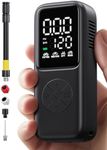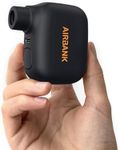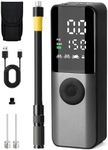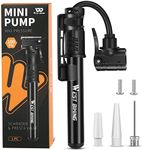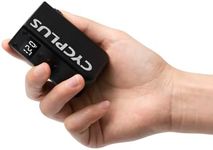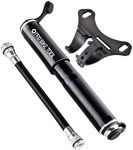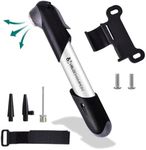Buying Guide for the Best Mini Bike Pumps
Choosing the right mini-bike pump is essential for any cyclist, whether you're a casual rider or a serious cyclist. A mini-bike pump is a compact and portable tool that allows you to inflate your bike tires on the go, ensuring you can maintain the correct tire pressure for a smooth and safe ride. When selecting a mini-bike pump, consider factors such as size, weight, compatibility with your bike's valve type, and the pump's efficiency. Understanding these key specifications will help you make an informed decision and choose a pump that best suits your cycling needs.Size and PortabilitySize and portability are crucial when selecting a mini-bike pump because you want something that is easy to carry without adding much weight or bulk to your ride. Mini-bike pumps come in various sizes, from very compact models that fit in a pocket to slightly larger ones that may require a frame mount. If you often go on long rides or have limited space, opt for a smaller, more portable pump. However, if you prioritize ease of use and efficiency, a slightly larger pump might be more suitable.
Valve CompatibilityValve compatibility refers to the pump's ability to work with different types of bike tire valves, primarily Presta and Schrader valves. This is important because using the wrong pump for your valve type can lead to frustration and inefficiency. Some pumps are designed to work with both valve types, while others are specific to one. If you have multiple bikes or are unsure of your valve type, a dual-compatible pump is a versatile choice. Otherwise, ensure the pump matches your bike's valve type for a hassle-free experience.
Inflation EfficiencyInflation efficiency is about how quickly and easily a pump can inflate a tire to the desired pressure. This is important because a more efficient pump saves time and effort, especially during a roadside repair. Pumps with higher pressure capabilities can inflate tires faster and to higher pressures, which is beneficial for road bikes that require higher PSI. If you ride a mountain bike or hybrid, a pump with moderate pressure capabilities may suffice. Consider your typical riding conditions and tire pressure needs when evaluating this spec.
Build Quality and DurabilityBuild quality and durability determine how well a pump can withstand regular use and the elements. A well-built pump made from quality materials like aluminum or reinforced plastic will last longer and perform better over time. This is important for reliability, especially if you frequently ride in varying weather conditions. If you ride often or in challenging environments, investing in a durable pump is wise. For occasional riders, a basic model with decent build quality may be sufficient.
Ease of UseEase of use refers to how simple and straightforward it is to operate the pump. This is important because a pump that is difficult to use can be frustrating, especially in emergency situations. Features like ergonomic handles, clear pressure gauges, and secure valve attachments contribute to ease of use. If you're new to cycling or prefer convenience, look for a pump with user-friendly features. Experienced cyclists might prioritize other specs, but ease of use is always a beneficial consideration.

